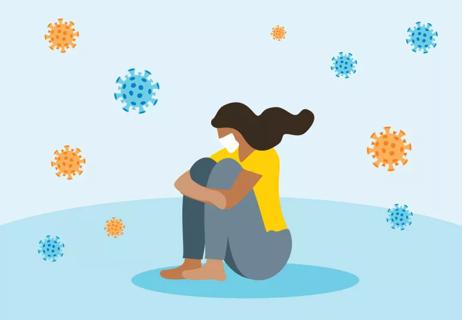The two main strains of the flu have a lot in common, but type A causes more cases and more severe illness than type B

There are some things you can count on as fall turns to winter. The days get shorter. There’s a chill in the air. And chances are good that a respiratory flu virus is beginning to spread.
Advertisement
Cleveland Clinic is a non-profit academic medical center. Advertising on our site helps support our mission. We do not endorse non-Cleveland Clinic products or services. Policy
Flu season in the United States typically starts in October and tapers off in late April. And there are two main strains of the influenza virus that cause our annual flu season: influenza A and influenza B.
If flu acted like a two-person relay race, you’d typically see influenza A at the starting block in autumn, and hitting its full stride by February. Come March, influenza B picks up the viral baton.
That said, the flu season can vary from year to year. For example, data from the U.S. Centers for Disease Control and Prevention (CDC) show the 2024-2025 flu season got a late start. The number of reported cases didn’t start climbing until late November.
Both virus strains have some characteristics in common, but there are also some key differences. Infectious disease doctor Sherif Mossad, MD, explains what sets them apart and why those differences matter.
Influenza A and influenza B have a lot in common. But there are some overarching differences between the two flu types. For example, influenza A usually accounts for more flu cases and causes more severe illness than type B flu. For example, flu A accounted for 96% of flu cases reported in late 2024.
Another difference is how the flu types affect kids. “In children, influenza A is associated with more ear infections than influenza B, while influenza B is associated with more seizures, vomiting and diarrhea than influenza type A,” says Dr. Mossad.
Advertisement
But the single most important difference is this: Influenza B flu only infects humans. Influenza A, on the other hand, can infect birds and mammals. This explains why antigenic shift can occur with influenza A, but not influenza B.
“Antigenic shift occurs when bird or animal influenza A is transmitted to humans. This results in pandemics, since humans don’t have specific immunity to these viral serotypes (groups of viruses),” shares Dr. Mossad.
Antigenic shift is the reason why influenza A can cause a pandemic. Both influenza A and influenza B can cause annual epidemics. Epidemics are declared when there are more cases of a specific disease than usual in a specific group of people. A pandemic happens when an epidemic affects thousands or even millions of people in several different countries or continents.
The 2009 A/H1N1 pandemic is an example of antigenic shift in action. In that case, an influenza A virus in pigs jumped to humans.
That leap launched the 2009 H1N1 (swine flu) pandemic that infected millions of people worldwide. Antigenic shift is also why healthcare providers keep a close eye on the currently occurring rare cases of A/H5N1 bird flu.
Antigenic drift is the other way flu evolves. In antigenic drift, the flu viruses make tiny changes (genetic mutations) from year to year.
“Antigenic drift occurs as a minor genetic mutation in either influenza A or B, resulting in possible reinfections year after year,” Dr. Mossad explains. “These mutations account for the annual influenza epidemics that make 10% to 20% of the population ill.”
Those differences aside, influenza A and B have important things in common:
An infection of the flu occurs when you come into contact with the flu virus. That can happen if you:
Anyone can catch these viruses. But babies and older adults are more likely to have more severe symptoms, Dr. Mossad shares.
Advertisement
“Younger babies (age 6 months and younger) are more likely to get infected and more likely to have severe disease caused by influenza than older children,” he notes.
Here’s why: Every time germs like a flu virus invade your kid’s body, their immune system adds details about the virus to its invader database and develops antibodies to protect against future invasions.
Older kids are more likely to have run into more flu viruses than babies, so their immune systems are better trained to fend off these viruses. That means they’ll likely have less serious flu symptoms than babies. And older children often get the flu shot during their annual check-up with their pediatrician. The vaccine isn’t approved for babies 6 months and younger.
Influenza A and influenza B can cause serious complications in people aged 65 or older. They may have more severe flu symptoms or develop a serious illness like pneumonia or myocarditis (inflammation of the heart muscle).
The risk for severe influenza-related illness is higher in older people because they’re more likely to have chronic diseases that worsen with flu, Dr. Mossad clarifies. The CDC reports that 9 of 10 people hospitalized for complications of flu had an underlying condition, like chronic obstructive pulmonary disease (COPD).
Advertisement
In some cases, medication to treat a chronic disease increases the risk of having severe complications of flu. For example, Dr. Mossad says that someone who has rheumatoid arthritis (RA) may need to take an immunosuppressant. This medication eases painful RA symptoms. But it also makes it harder for your immune system to fight off the flu.
In general, you feel lousy whether you have influenza A or influenza B. Unlike the common cold that can creep up on you, flu symptoms hit right away, and they hit hard. Both influenza A and influenza B typically kick off with a fever. Next, comes any combination of symptoms like:
“The sudden onset of fever, cough and a headache are reasons to call your doctor,” Dr. Mossad advises. And again, he emphasizes that people with underlying chronic medical conditions or are immunocompromised as a result of certain diseases or medications should seek care early even if they have relatively mild symptoms.
“Treatment reduces symptoms and shortens illness when started early, so why stay miserable?” he poses. Another benefit of early treatment is preventing the spread of infection to contacts at risk for severe flu-related illness.
Advertisement
Dr. Mossad typically does nasal or throat flu tests to confirm the diagnosis. Your provider can prescribe antiviral drugs that have U.S. Food and Drug Administration (FDA) approval to treat influenza early (one or two days within the onset of symptoms ):
Regardless of influenza type, Dr, Mossad says that the most important things are taking care of yourself and doing your best to avoid spreading the virus.
If the flu bug bites, taking over-the-counter medications like acetaminophen will help with body aches, headache and fever. Here are some other suggestions:
That last suggestion is very important. You may think you can tough it out and go about your day. Again, resist that urge, especially if your daily routine means you’re frequently around many other people.
“In particular, you should stay away from other people who may be at risk for severe illness from the flu,” Dr. Mossad emphasizes. That includes babies, people who are pregnant, people aged 65 and older and people who have chronic illnesses.
You may not be able to avoid encountering the flu. But there are many ways to help reduce your risk of flu-related illness.
Many doctors recommend the flu shot each year as one way to lower your risk, especially for those more vulnerable to complications. Other best practices are:
Some viruses make you immune once you’ve had them. Sadly, influenza A and influenza B aren’t among them. “One can get flu A then flu B (or vice versa) in the same flu season,” Dr. Mossad warns.
Influenza A and influenza B may have plenty in common. But the ways in which they’re different can affect how the flu affects you. Knowing the type of influenza that you have can help healthcare providers select the medication that’s right for you.
And because experts track the differences in how influenza A and influenza B spread, that can help providers plan ways to manage flu season, like letting people know when the flu types are spiking in their communities.
Learn more about our editorial process.
Advertisement

From washing your hands and disinfecting surfaces to boosting your immune health, there are many ways to reduce your flu risk

Pasteurized milk is considered safe, but there are concerns about avian influenza spreading through raw, unpasteurized milk

The flu can make kids seriously sick, so watch for signs of dehydration and breathing problems

Tamiflu can shorten your child’s illness and even help prevent the flu

You may be spreading the flu virus before your symptoms start and up to a week after

While it typically starts in October, vaccine effectiveness can affect its duration and severity

Influenza puts stress on your body and can lead to serious conditions like pneumonia or stroke

There are three antigenic types of influenza, but A and B are responsible for our flu season

Babies can get congested easily, but you can calm their cough by keeping them hydrated, using nasal drops and running a humidifier

Weight loss may cause loose, sagging skin and muscle loss to your rear

Several conditions, like vitiligo and fungal infection, can cause a loss of pigmentation, leading to white spots or patches on your skin